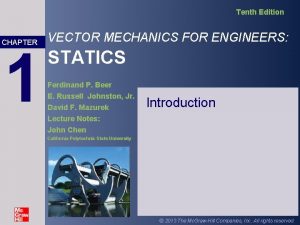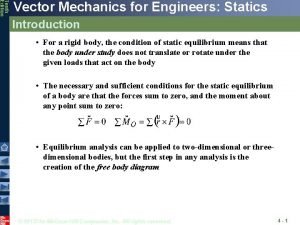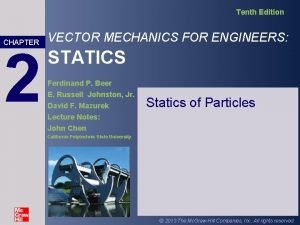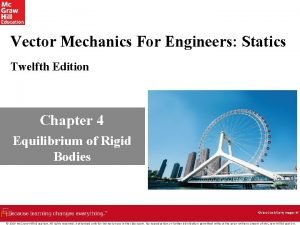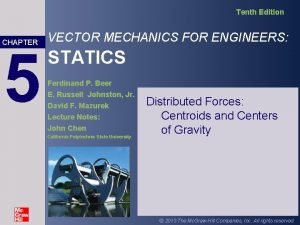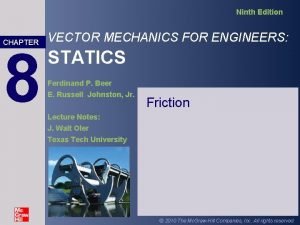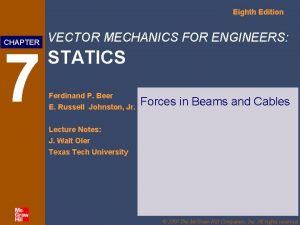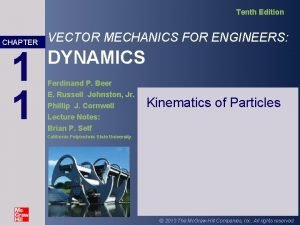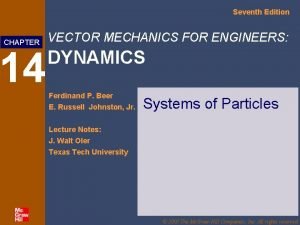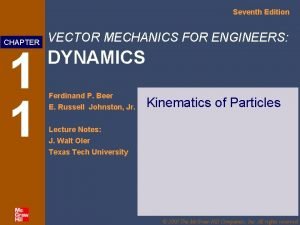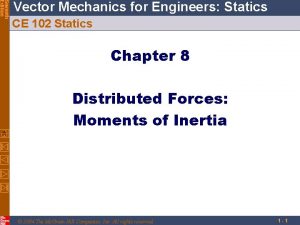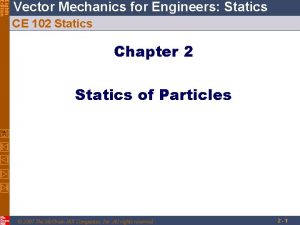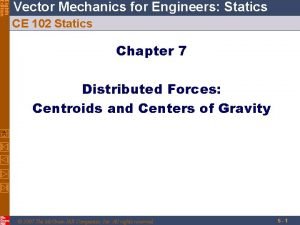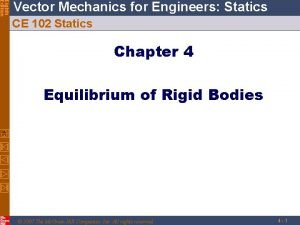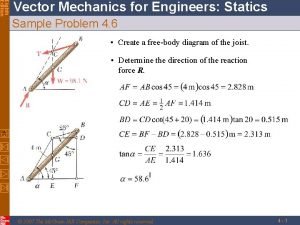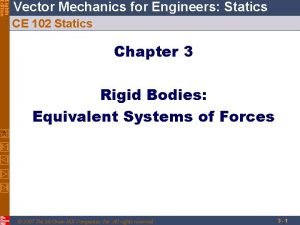Tenth Edition Vector Mechanics for Engineers Statics WELCOME











- Slides: 11

Tenth Edition Vector Mechanics for Engineers: Statics WELCOME TO ENGR 2301 ENGINEERING STATICS Your Instructor: Edmund Morris edmund. morris@hccs. edu Web address: http: //learning. hccs. edu/faculty/ edmund. morris © 2013 The Mc. Graw-Hill Companies, Inc. All rights reserved. 2 -1

Tenth Edition CHAPTER 1 VECTOR MECHANICS FOR ENGINEERS: STATICS Ferdinand P. Beer E. Russell Johnston, Jr. David F. Mazurek Introduction Lecture Notes: John Chen California Polytechnic State University © 2013 The Mc. Graw-Hill Companies, Inc. All rights reserved.

Tenth Edition Vector Mechanics for Engineers: Statics Contents What is Mechanics? What Can You Do with Statics Knowledge? Systems of Units Method of Problem Solution Numerical Accuracy © 2013 The Mc. Graw-Hill Companies, Inc. All rights reserved. 1 -3

Tenth Edition Vector Mechanics for Engineers: Statics What is Mechanics? • Mechanics is the study of bodies under the action of forces. • Categories of Mechanics: - Rigid bodies - Statics – bodies at rest or at constant velocity - Dynamics – accelerating bodies - Deformable bodies - Fluids – gas and/or liquid • Mechanics is an applied science, closely related to physics, so many of the concepts will build on that prior knowledge. • Mechanics is the foundation of many engineering topics and is an indispensable prerequisite to their study. © 2013 The Mc. Graw-Hill Companies, Inc. All rights reserved. 1 -4

Tenth Edition Vector Mechanics for Engineers: Statics What Can You Do with Statics Knowledge? Calculate the force in each member of this structure (a truss) in order to design it to withstand the loads that it will experience. © 2013 The Mc. Graw-Hill Companies, Inc. All rights reserved. 1 -5

Tenth Edition Vector Mechanics for Engineers: Statics What Can You Do with Statics Knowledge? Determine the forces that this prosthetic arm will need to withstand to make exercise possible for the wearer. © 2013 The Mc. Graw-Hill Companies, Inc. All rights reserved. 1 -6

Tenth Edition Vector Mechanics for Engineers: Statics What Can You Do with Statics Knowledge? Design the joints and support of the Shuttle Remote Manipulator System (SRMS) so that it can be used to pick up and support various payloads. © 2013 The Mc. Graw-Hill Companies, Inc. All rights reserved. 1 -7

Tenth Edition Vector Mechanics for Engineers: Statics Systems of Units • Kinetic Units: length, time, mass, and force. • International System of Units (SI): The basic units are length, time, and mass which are arbitrarily defined as the meter (m), second (s), and kilogram (kg). Force is the derived unit, • Three of the kinetic units, referred to as basic units, may be defined arbitrarily. The fourth unit, referred • U. S. Customary Units: to as a derived unit, must have a The basic units are length, time, and definition compatible with Newton’s force which are arbitrarily defined as the 2 nd Law, foot (ft), second (s), and pound (lb). Mass is the derived unit, © 2013 The Mc. Graw-Hill Companies, Inc. All rights reserved. 1 -8

Tenth Edition Vector Mechanics for Engineers: Statics Conversion of units • There are many instances when conversion from U. S. system to SI system or vice versa is required. Since the unit of time is the same in both the system, only two kinetic base unit need to be converted. • 1 ft = 0. 3048 m and 1 lb = 4. 448 N • This makes 1 slug = 14. 59 kg. • Since all other kinetic units and conversion factors can be derived from these base units. • • E. G. 1 mi = 5280 ft = 5280·(0. 3048 m) =1609 m = 1. 609 km Equivalent quantities, such as 1 hour = 60 minutes, can be written as ratios whose values are 1: (1 h/60 min) = 1, and used to convert units, For example, 15 min = 15 min(1 h/60 min) = 0. 25 h. © 2013 The Mc. Graw-Hill Companies, Inc. All rights reserved. 2 -9

Tenth Edition Vector Mechanics for Engineers: Statics Method of Problem Solution • Problem Statement: • Solution Check: Includes given data, specification of - Test for errors in reasoning by what is to be determined, and a figure verifying that the units of the showing all quantities involved. computed results are correct, - test for errors in computation by • Free-Body Diagrams: substituting given data and computed Create separate diagrams for each of results into previously unused the bodies involved with a clear equations based on the six principles, indication of all forces acting on each - always apply experience and physical body. intuition to assess whether results seem “reasonable” • Fundamental Principles: The six fundamental principles are applied to express the conditions of rest or motion of each body. The rules of algebra are applied to solve the equations for the unknown quantities. © 2013 The Mc. Graw-Hill Companies, Inc. All rights reserved. 1 - 10

Tenth Edition Vector Mechanics for Engineers: Statics Numerical Accuracy • The accuracy of a solution depends on 1) accuracy of the given data, and 2) accuracy of the computations performed. The solution cannot be more accurate than the less accurate of these two. • The use of hand calculators and computers generally makes the accuracy of the computations much greater than the accuracy of the data. Hence, the solution accuracy is usually limited by the data accuracy. That is, remember what you learned about significant figures. • As a general rule for engineering problems, the data are seldom known with an accuracy greater than 0. 2%. Therefore, it is usually appropriate to record parameters beginning with “ 1” with four digits and with three digits in all other cases, i. e. , 40. 2 lb and 15. 58 lb. © 2013 The Mc. Graw-Hill Companies, Inc. All rights reserved. 1 - 11
 Vector mechanics for engineers statics 10th edition
Vector mechanics for engineers statics 10th edition Vector mechanics for engineers
Vector mechanics for engineers Vector mechanics for engineers statics 10th edition
Vector mechanics for engineers statics 10th edition Mechanics for engineers
Mechanics for engineers Static equilibrium
Static equilibrium What is line of action
What is line of action Vector mechanics for engineers
Vector mechanics for engineers Vector mechanics for engineers
Vector mechanics for engineers Vector mechanics for engineers
Vector mechanics for engineers Vector mechanics for engineers: dynamics
Vector mechanics for engineers: dynamics Vector mechanics for engineers: dynamics
Vector mechanics for engineers: dynamics Vector mechanics for engineers dynamics 12th
Vector mechanics for engineers dynamics 12th
